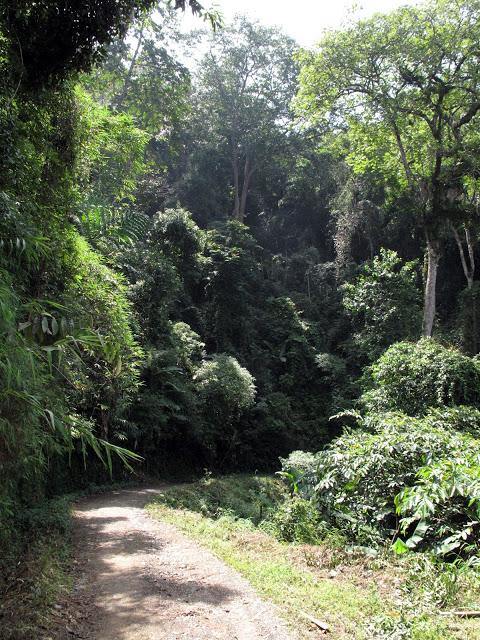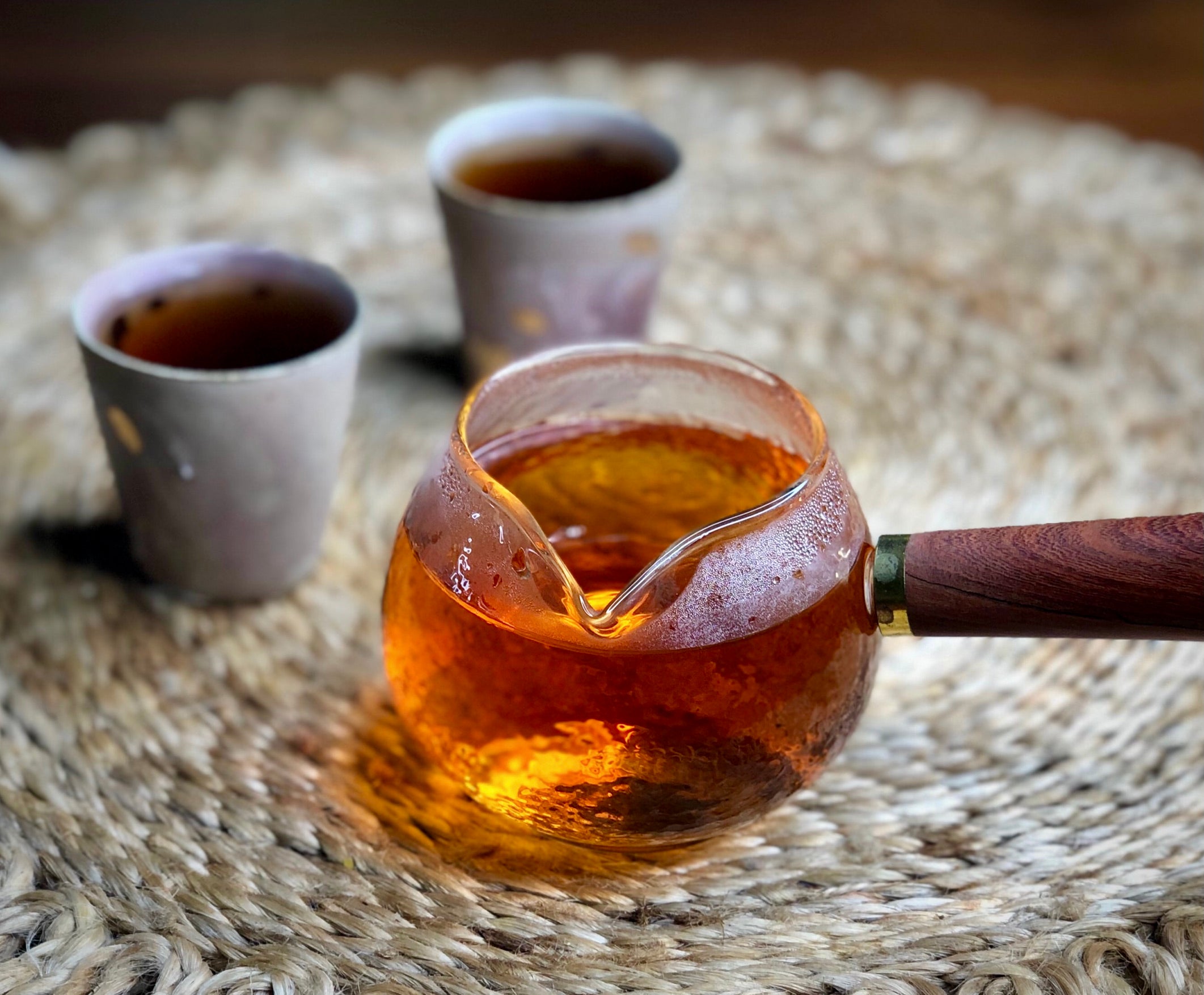
The long & winding road to Mang Zhi
The great thing about dirt roads is they impart a sense of adventure and freedom. The more distance you put between yourself and civilisation, the more chance you'll find some wondrous, unspoilt tea garden. I had to remind Belle of this as we endured a 5 hour bumpy ride north from Yiwu town, passing through young banana & rubber plantations in the valleys around Xiangming, then climbing through temperate rainforest to the hilltop villages of Mang Zhi (莽枝), on the border of Xishuangbanna & Simao prefectures. Just for fun, I decided to ride the last leg of the journey on the back of the "ute." With the wind in my hair, warm sunlight beating down through the leaves, I was in that heavenly third space between origin and destination - the apex of a journey where you don't want to stop, nor to arrive.

Hiking up the trail to Mangzhi's Imperial Tea Garden 皇家茶园
I had heard that Mang Zhi was a bit of a hidden gem, and on seeing the trees I was at once impressed by the biodiversity of the tea gardens. Growing at 1325m elevation, there are a few ancient trees that are claimed to be 500 years old, surrounded by 4-5m high younger trees, with stout trunks as thick as a man's arm. Many of the younger trees have been allowed to grow straight up, sprouting slender branches from shoulder height that need to be bent over backwards to be picked.
We inspected two tea gardens on different parts of the mountain - the first boasted the colorful name of "Imperial Tea Garden" (皇家茶园) because the Emperor supposedly once ordered tea from this garden. The exact details of this imperial order were rather sketchy, but it was a beautiful, lush garden nonetheless, located in a sun lit forest clearing on a steep slope with good drainage. The tea trees hosted a good variety of lichen & mosses, and I clumsily stumbled through many arachnid homes as I made my way through the trees. Most pleasing of all was the thick natural ground cover - no weed killer used here!

A 10m tall tree in Mangzhi's Imperial Tea Garden

莽枝大叶种普洱茶茶果 Mang Zhi tea seeds & seedpod
The second tea garden we visited was "Hong Tu Po" or "Red Earth Hill" (红土坡). Little goats cavorted under its trees. Goats are known to eat anything, but the shepherds told me these little fellas have learnt to respect the tea trees, and happily convert the weeds into tea tree fertilizer.

Baby goats playing amongst the tea trees at Hong Tu Po, Mangzhi

Ancient tea tree in Hong Tu Po 红土坡, Mangzhi 莽枝
We ate lunch and dinner at a local maocha processing workshop (初制所 or "chu zhi suo"). A "chu zhi suo" is an initial processing facility where fresh tea leaves are fried, rolled and dried into maocha - the raw material for making pu'er cakes. I accompanied our host Mr. Yang as he did his nightly rounds, visiting each family in turn, inspecting, weighing & collecting the day's harvest of fresh tea leaves. The farmers here pick their own trees, and sell the leaves to Mr. Yang's factory at the end of each day. This way, the farmers can spend more time picking, convert their leaves to cash quickly, and don't have to go through the tiring process of firing & rolling the tea leaves. The tea buyer gets better consistency & higher quality maocha from centralised processing by highly skilled technicians.Whilst it's charming to watch the farmers wok fry & roll leaves, they do it with varying degrees of proficiency & hygiene. So the "initial processing facility" is becoming more widespread throughout Yunnan's tea villages. Smaller than a factory, it's more like a large shed where tea producers can bring their fresh leaves and process it according to their customer's specifications.

Mr. Yang buying freshly picked tea leaves from the farmers

Weighing the day's tea harvest
Into each sack went a little piece of paper with the farmers name & the location of the tea garden. No cash was exchanged. Mr. Yang just scribbled numbers in his little black book. I guess they tally up at the end of the week, or when Mr. Yang gets his payment from buyers like myself.
Mr. Yang had hired two stocky technicians from Simao to help him do the shaqing & rou nian. These young men were both in their 20s but already highly talented at the art of firing & rolling leaves. We asked them why they didn't practice this art in their hometown. They said it was because only tai di cha (industrial scale terraced tea plantations) was grown there, and it wasn't worth hand processing. They can earn more as gushu tea firers than farming their own land.

Mangzhi maocha stored in a clay pot
Mr. Yang served us a "medium rare" puer. This maocha had been wok fried for a shorter time than normal, which Mr. Yang described as 广东做法 or "the Guangdong method". It looked the same as traditionally processed maocha but tasted more green & astringent. Apparently this sells well in Guangdong province, where perhaps due to the humidity, they prefer this fresher, grassy flavour. I asked Mr. Yang if this shortened shaqing process meant the maocha would oxidize faster or adversely affect the tea's aging. He said it wasn't noticeable if drank whilst young, but over time, tea processed this way can develop a slight sour note. Another producer told me cakes produced in this way are less likely to rot in the middle when placed in Guangdong wet storage (high temperature, high humidity), and can be made to look like much older cakes after a few years in such storage conditions. This sounds more like speculation or hearsay to me, but interesting nonetheless.

A gaiwan full of "medium rare" 广东做法 Mangzhi puerh
Outside one farmer's house, I spotted some tea flowers being dried in the sun. They were going to be pressed into the face of a puer cake as decoration. I imagine this looks very attractive, but I wonder if the dried flowers will continue to decompose & eventually taint the tea. Still, it was fascinating to see this kind of experimentation in beautiful Mangzhi.

茶花 Sun dried tea flowers

Tea Urchin Mangzhi cake - 2011 Autumn
If you are interested in trying our Mangzhi tea, we bought & stone pressed 30kg of Mr. Yang's Autumn gushu picked from the Imperial Tea Garden & Red Earth Hill garden. These 357g cakes sell for $56 each on the Tea Urchin online shop.


